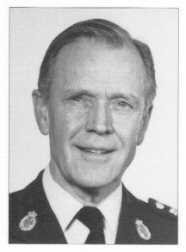
 In the text about the Memorial Stone in Rebild
Hills to 69 Allied airmen who lost their lives in
supply operations to the Danish
In the text about the Memorial Stone in Rebild
Hills to 69 Allied airmen who lost their lives in
supply operations to the Danish
Resistance it is mentioned
that it was erected in 1990 on the
initiative of
Colonel Helge W. Gram.
In
1988 his idea of a memorial was supported
by 5 prominent figures from the
Danish resistance movement
and the leading
historian of underground warfare in Denmark.
Flemming Juncker, Anton Toldstrup, Svend
Truelsen, Ole Lippmann, Erik Frandsen
and Jørgen Hæstrup signed
an Appeal for a memorial to 69
Allied airmen.
To find the right stone,
decide on the inscription and the design, find the right place for the
memorial stone, get the work done and
paid for, to arrange a suitable unveiling
with invited guests and people
with an interest in airmen demanded a good cooperation
between many people –
and Helge W. Gram pulled the right strings.
Crown Prince Frederik unveiled the memorial on 5 May 1990,
see photos from the event.
Equerry to
the Queen
behind Rebild-monument
was the headline in
the Flensborg Avis on 26 August 1989, written by Erik Eriksen. (Abstract:)
Helge William Gram,
Colonel, retired, was born on 2 December 1929 in Copenhagen.
He served in the Danish Army from 1948 until 1992, the last six years as
First and Principal Military Aide-de-Camp to Her Majesty the Queen of
Denmark.
During this service he was appointed Chamberlain and
Knight Commander 1st Class of the Order of the Dannebrog. He lives in
Zealand with his wife Gerda Lunn Gram, Ph.D. |
For a number of
years Colonel Helge Gram, with
the official title First and Principal Military Aide-de-Camp to Her Majesty
the
Queen of Denmark has been occupied with the air
war over Europe during World War 2. He has calculated that allied planes
flew
over Denmark about 40,000 times on their way to or from bombing raids
on Germany or minelaying operations. Only a very small
part of the flights
involved supplies of weapons for the Danish resistance.
During 677 sorties in 415
operations only 18 planes were lost. From 15 planes
69 airmen lost their
lives. Nearly 400 places in
Denmark were accepted as drop zones – 280 in
Jutland, 80 in Zealand and 30 in Funen. From August 1944 and to the end of
the
war 6,245 containers with 655 tons of
weapons, explosives, ammunition
and radio equipment were received in 277 drop zones.
(See
Google Map Rebild with the 15 planes lost with the loss of 69 lives
+ 3 planes lost without loss of lives. AS)
“But the 677 sorties
left a lasting impression on the years of occupation, ensured the arming of the resistance
movement and
provided the material basis for at least 4,481 sabotage
actions: 1,810 against railways and 2,671 against industrial companies
working for the occupation forces. (Successful airdrops over DK: RAF 284,
USAAF 168. Failed: 225 sorties.
284+168+225=677)
With the mapping of the
supply flights I have tried to get some knowledge of what happened, when I
was only a big boy.
How the
basis for the armed resistance was provided. What happened to the weapons
that the allied provided the resistance fighters with at such great costs, and the allied losses due to these supply
operations.” (Flensborg Avis)
In 1998 Helge W. Gram
wrote Shot down over Denmark – a fine book with an overview and many
details, still for sale at
The Museum of Danish Resistance.
In 1994 the
CWGC
accepted that a till then unknown Squadron Leader buried in
Esbjerg had to
be Squadron Leader
John Colverd Richards from LAN ED818.
In 1998 The Denmark Team (Niels
Erik Stampe, Anders Bjørnvad, Ole Rønnest, R.G. Cobley and Helge W. Gram,
all of them
MBE)
identified
the airmen Cochrane, Cowham,
Carter and Sidwell. After investigation of
LAN ED709
at the bottom of Ringkøbing Fjord the team also found and identified Whellams
in 1998.
The 5 airmen are buried in Lemvig.
In 2000 Helge W. Gram identified the Norwegian Sub Lieutenant
Herman Hirsch Becker from the Shell House Attack. See
RAF-memorial.
He rests in Tranebjerg.
In 2002 he started the work of convincing the
CWGC that it was Halifax DT628 that
crashed at Halskov and that the crew were taken to
Bispebjerg Cemetery.
A little hard to explain why there are only 6 headstones to unknown airmen
with the date 21st April 1943 when there were 8 airmen in the aircraft. In
2011 I did it.
One of the most important pieces in the puzzle was
his document from Luftgaukommando XI stating that the bomber that
crashed at Halskov was a Halifax!
Unfortunately it appeared to be a Lancaster, so the German report was wrong.
Since 2008 Helge W. Gram
supported my work with
www.airmen.dk in many ways – and after his death his comprehensive
archive was passed on to me.
After me it will be passed on to
the
Archives of Danish Occupation
History 1940-1945. His work and knowledge of Allied airmen was very impressing!
On Saturday 7 November 2009 he was pleased to
see most of this page in a preliminary Danish version. Helge W. Gram passed away on
Friday 13 November 2009!
|
